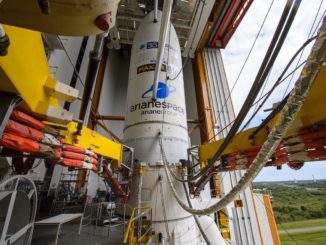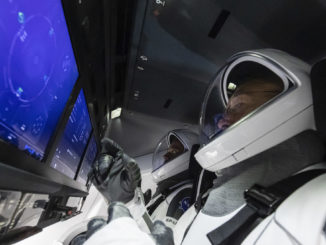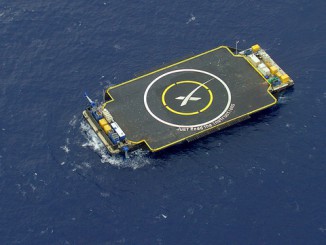WHITE SANDS MISSILE RANGE, New Mexico — A Boeing Starliner crew capsule fired off a stand early Monday at White Sands Missile Range in New Mexico on a mile-high test flight to validate the spacecraft’s emergency escape thrusters.
Only two of the ship’s three main parachutes deployed on descent, but Boeing officials do not expect any impacts on the planned launch of an unpiloted Starliner demonstration mission to the International Space Station in December.
The capsule did not fly with any astronauts Monday when it launched off a pad at White Sands on a fast-paced test flight, which lasted around 78 seconds from liftoff through landing.
But a lot happened during the flight, called a pad abort test, exercising the Starliner spacecraft’s abort engines, control thrusters, flight software, jettison mechanisms and parachutes.
The 16.5-foot-tall (5-meter) capsule propelled itself off its test stand at 7:15 a.m. MST (9:15 a.m. EST; 1415 GMT) Monday. The Starliner used the same launch pad originally built for a pad abort test of NASA’s Orion crew capsule in 2010.
Other than the parachute deployment failure, everything appeared to work as designed on Monday’s pad abort test.
“It’s designed to operate with two chutes, and operate well,” said Chris Ferguson, a Boeing test pilot and astronaut who will fly on the Starliner’s first crewed space mission next year. “Everything landed well, all the airbags functioned properly. I was just super-jazzed that we got to where we were.”
In a statement after Monday’s test, Boeing said engineers will review data from Monday’s pad abort test to “determine how all of the systems performed, including the parachute deployment sequence.”
“It’s too early to determine why all three main parachutes did not deploy, however, having two of three deploy successfully is acceptable for the test parameters and crew safety,” Boeing said in a statement. “At this time we don’t expect any impact to our scheduled Dec. 17 Orbital Flight Test. Going forward, we will do everything needed to ensure safe orbital flights with crew.”
During a crewed launch, emergency escape engines on the base of the Starliner’s service module would propel the spacecraft off the top of its United Launch Alliance Atlas 5 rocket in the event of a failure on the launch pad at Cape Canaveral. The pad abort test Monday proved the Starliner’s escape system is up to the challenge.
“This is a system we hope to never use, but it’s a system that we have to have so that we can have the ability to abort any time on the way up, whether we’re on the pad all the way to aborting to orbit,” said Mike Fincke, a veteran NASA astronaut who will join Ferguson on the Starliner’s Crew Flight Test. “And today we saw a successful test, where we saw that the our revolutionary pusher abort system could pull us away from a launch vehicle that was in trouble and get us a mile up and a mile across away to safety.”
First-time space flier Nicole Mann, a U.S. Marine Corps test pilot, will join Ferguson and Fincke on the Crew Flight Test to the space station. The astronauts are expected to live and work aboard the orbiting research complex for up to six months.
Boeing is developing the Starliner spacecraft under a $4.2 billion contract with NASA. The space agency also awarded a $2.6 billion contract to SpaceX for development of the Crew Dragon spacecraft, giving NASA two new commercial crew capsules to fly astronauts to the space station, ending U.S. reliance on Russian Soyuz vehicles for the job.
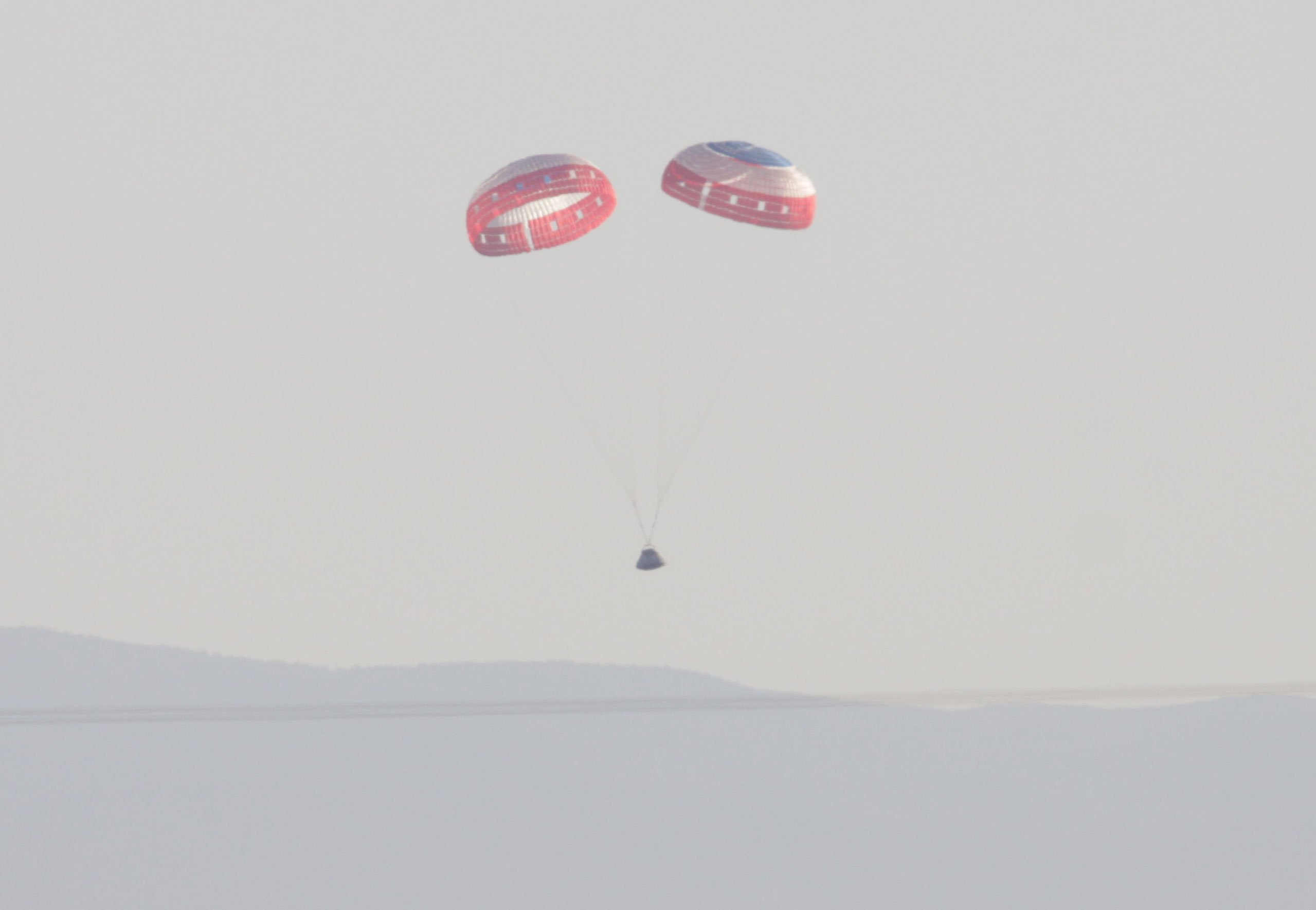
Monday’s pad abort test at White Sands went by quickly, with a few flashes and bangs before two of the three main parachutes opened and six airbags inflated to bring the capsule gently back to the ground.
“While it was unintentional, we demonstrated that you can safely land with two parachutes, so I look at that as a plus,” Ferguson said. “We’re certainly going to look at what happened to the third (parachute).
“Parachutes are obviously a very important element in all of this, and there’s a fair amount of concern that’s arisen lately over parachutes, not just in our program but across all human spaceflight programs,” Ferguson said in an interview with Spaceflight Now after Monday’s pad abort test. “Even on Mars, you’ve seen they’ve had some problems with ExoMars and their parachutes. So we’ll take a very good look at this. We’ll make sure that we understand what the root cause was, and make sure that we’ve adequately mitigated whatever caused it before we take humans on-board.”
An early assessment of video imagery and data from Monday’s test flight suggests the third main parachute never deployed, Boeing officials said. Engineers will inspect the recovered crew module to search for the cause of the parachute issue.
“Some of the folks who have the opportunity to go back and review it say that the pilot chute did come out, but then we don’t know what happened after that,” Ferguson told Spaceflight Now. “The pilot chute is designed to pull the main chute out, and we confirmed that the pilot chute came out, which means that the mortar that fires the pilot chute functioned properly, but what happened beyond that, it’s too early to speculate.”
Ferguson reiterated the official Boeing statement suggesting the company expects the parachute issue to have no impact on the Dec. 17 launch date for the Starliner’s first test flight in space.
He said there are “subtle differences” in the parachute system between the pad abort test vehicle, which is not intended to fly in space, and the next two Starliner spaceships. The differences “would enable us to confidently go into OFT without having to sort of retract and go and fix a problem that we observed,” Ferguson said.
“But again, we have to wait for the … investigation to sort of play out and make sure we understood what the root cause of it was,” he said.
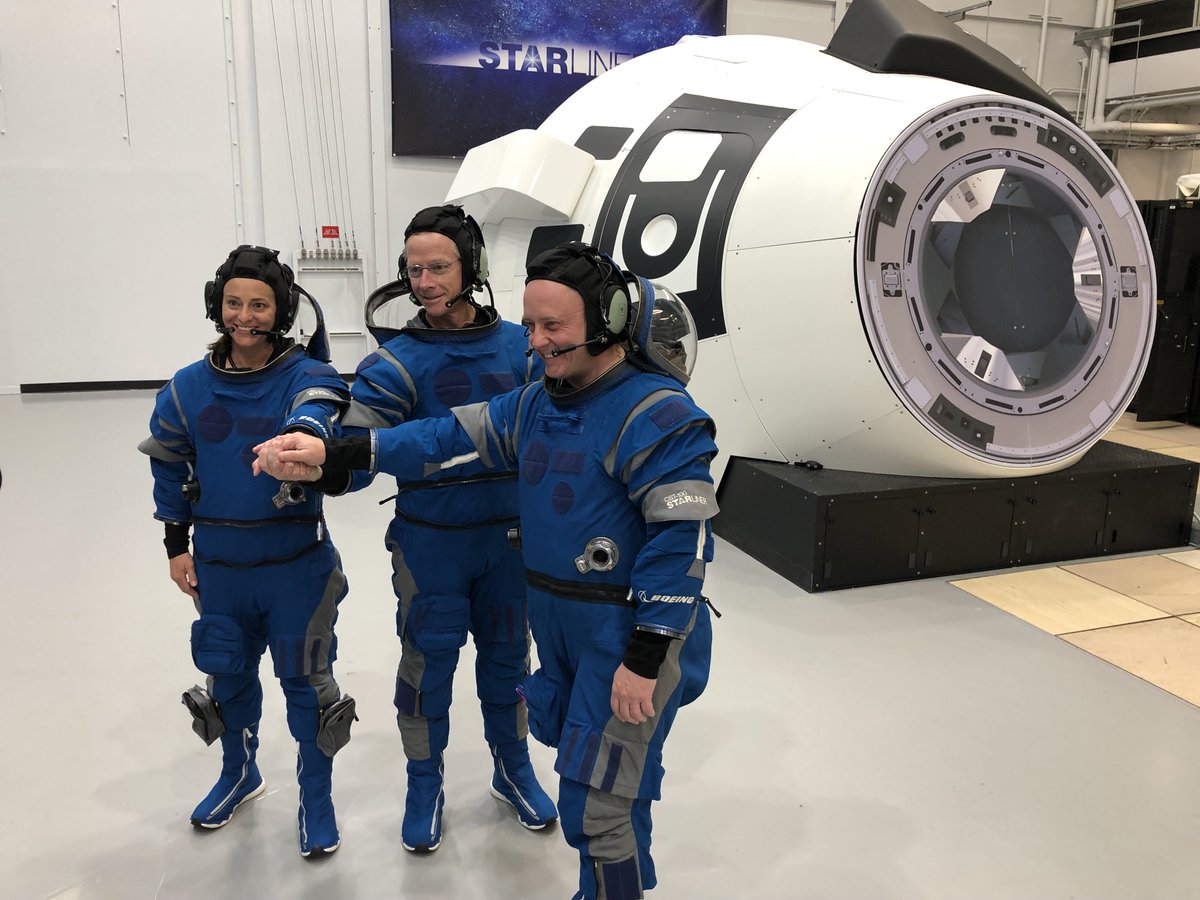
Although the pad abort test capsule lacked some crew systems, such as cockpit displays, the spacecraft tested Monday is largely the same as the two reusable space-rated capsules under construction at NASA’s Kennedy Space Center in Florida.
“This is a full-up Starliner,” said Alicia Evans, Boeing’s pad abort test flight director, in a NASA podcast last week. “It’s been built up specifically for this test. But because we were testing the integrated system, it has all of the systems required for the pad-abort test, and it’s full-up avionics capability, propulsion.”
At the start of Monday’s test flight, a command triggered specially-designed valves to quickly open inside the Starliner’s service module, and a high-pressure mix of liquid hydrazine and nitrogen tetroxide propellants rushed into four launch abort engines, or LAEs. The chemical propellants automatically combusted when mixed together, generating 40,000 pounds of thrust from each of the Aerojet Rocketdyne-made engines.
The engines, coupled with thrust from 12 smaller orbital maneuvering and attitude control rockets, or OMACs, pushed the Starliner vehicle off the ground with nearly 180,000 pounds of thrust. The capsule was expected to experience a sustained force of 5 Gs for five seconds while the launch abort engines fired, the same force astronauts would be under during a real abort off the launch pad.
Before Monday’s test, the Starliner capsule was mounted on top of the same type of adapter that will connect the real spacecraft to the top of ULA’s Atlas 5 rocket. When the craft ignited its four launch abort engines, vent doors on the adapter were designed to open, preventing an over-pressure event.
“At the launch pad, you have the rocket standing next to its gantry,” Evans said. “You have a launch vehicle adapter, which is structural hardware that adapts the launch vehicle to the Starliner. So that’s how we interface to it. Then you have the Starliner sitting on top of the rocket. And we have a service module as well as a crew module, which is the (combined) Starliner.
“During an abort, if there was to be an accident with the rocket and we needed to save the crew, what would happen is we have four large launch abort engines that fire in conjunction with several more smaller thrusters, called our orbital maneuvering and attitude control thrusters,” Evans said. “And that combined collection of thrusters lifts the Starliner away from the rocket and outside of any debris or blast zone that might be created by a rocket.”
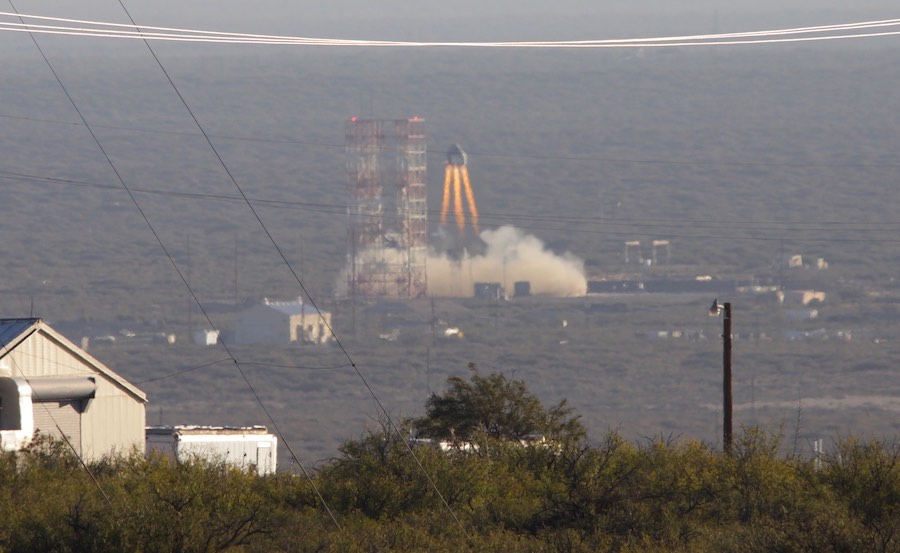
During Monday’s test, the abort engines were to fire for 5.1 seconds, propelling the Starliner from zero to some 650 mph.
Then thrusters pulsed to flip the spacecraft around and fly tail first on an arc that was expected to take the vehicle to a maximum altitude of approximately 4,426 feet (1,349 meters) above ground level around 18.6 seconds after takeoff.
The thrusters stopped firing 17 seconds after takeoff, and a series of pilot, drogue and main parachutes began deploying at about T+plus 20 seconds.
The craft jettisoned its service module at T+plus 34 seconds to fall to the ground. The crew module then released its base heat shield, then inflated airbags to cushion the capsule’s landing at White Sands.
On an actual space mission, the Starliner’s service module will separate from the crew module in space, then burn up during re-entry into the atmosphere. Engineers were eager to capture video tracking of the jettison system’s function during the pad abort test, along with observations of the heat shield separation events.
Residual propellant inside the service module, which contains all the engines used for the abort test, ignited with a flash upon impact. The crew module descended to its airbag-cushioned landing nearby.
SpaceX completed the pad abort test for its Crew Dragon spacecraft at Cape Canaveral in 2015, and plans an in-flight abort test later this year at the Kennedy Space Center to verity the capsule’s ability to fire off a Falcon 9 rocket after liftoff. Boeing plans to bypass such an in-flight abort demonstration.
Other U.S. space capsules, such as the Apollo command module, the Orion crew vehicle, and SpaceX’s Crew Dragon, are designed to splash down in the sea under parachutes. The Starliner, like Russia’s Soyuz spacecraft, will come back to Earth and touch down on land.
Under the guidelines of the commercial crew contracts, NASA gave Boeing and SpaceX the option to decide whether or not to conduct an in-flight abort test.
“Boeing is not going to do an in-flight abort test,” said Jon Cowart, deputy manager of the mission management office for NASA’s commercial crew program, before the pad abort test. “They’re just going to do the ground one. They think that they can get enough data and then extrapolate that out, with good analytical techniques that we’ve endorsed. They will go and do it in that particular way, versus SpaceX, which is going to do both.
“We knew about this up front, both Boeing and SpaceX, when they proposed their contracts to us and said, ‘This is how we’re going to get to real flights,'” Cowart said last week in a NASA podcast. “We understood exactly, and we bought into it. We think, and we agree with them, that we can get all they need from a pad-abort test.”
Kathy Lueders, who manages the commercial crew program at NASA, last week called the Boeing pad abort “a huge test for us.”
“Obviously, it’s going to be important for us to understand how the separation works for the CM and SM (crew module and service module), checking out the chutes, making sure that the predictions are lined up right for us,” Lueders said last week during a presentation to the NASA Advisory Council’s human exploration and operations committee.
Boeing is in the final stages of assembling and testing two space-ready Starliner vehicles inside a former space shuttle hangar at NASA’s Kennedy Space Center in Florida.
The first of the capsules is scheduled to launch on an Atlas 5 rocket as soon as Dec. 17 from pad 41 at Cape Canaveral Air Force Station for a week-long unpiloted test flight to the space station. That mission, called the Orbital Test Flight, will not have an active abort system, but Lueders said NASA wants to see how the Starliner performs on the abort test before going ahead with the OFT mission.
“OFT does not have the abort system on it because it’s an uncrewed mission, but obviously the way the system separates and everything else will reflect on our OFT progress, so it’s critical for us to get this test going and that we understand it prior to us doing rollout of the spacecraft (for OFT),” Lueders said last week, referencing the pad abort test.
The Starliner’s Crew Flight Test to the space station is scheduled to follow some time in the first half of 2020, with Ferguson, Fincke and Mann on-board.
While final preparations for the pad abort test were underway in New Mexico, Boeing technicians at the Kennedy Space Center in Florida were readying the first space-ready Starliner spacecraft for fueling. Later this month, it will be installed on top of the Atlas 5 rocket at Cape Canaveral for final integrated checkouts and a full countdown rehearsal ahead of its scheduled liftoff in mid-December.
The commercial crew program is a new paradigm for NASA. Boeing and SpaceX are in charge, but because NASA is the only customer for the new spaceships so far, the government still has a big say in how the contractors run the program.
“They own the flight tests,” Cowart said. “Even when they start flying up in the space station, they own the spaceship, they own the rocket. But these particular tests — they own them, which means we will consult with them, but in the end, they are the ones who own the tests and the results.
“It’s part of their certification,” he said. “They’ve got to bring the data from those tests to us before they can go fly our astronauts on-board. And we’ve got to say that, ‘Yeah, you’ve got the right amount of data and that the data is good and that the vehicle will perform correctly.’ But … this is the thing that’s kind of different from the way NASA has done business in the past. We don’t own the rocket. We don’t own the spaceship … It’s something more than consulting and something less than owning.”
Email the author.
Follow Stephen Clark on Twitter: @StephenClark1.

